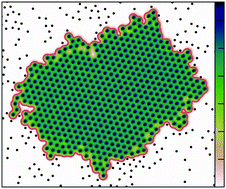Nucleation pathway and kinetics of phase-separating active Brownian particles†
Abstract
Suspensions of purely repulsive but self-propelled Brownian particles might undergo phase separation, a phenomenon that strongly resembles the phase separation of passive particles with attractions. Here we employ computer simulations to study the nucleation kinetics and the microscopic pathway active Brownian disks take in two dimensions when quenched from the homogeneous suspension to propulsion speeds beyond the binodal. We find the same qualitative behavior for the nucleation rate as a function of density as for a passive suspension undergoing liquid–vapor separation, suggesting that the scenario of an effective free energy also extends to the kinetics of phase separation. We study the transition in more detail through a committor analysis and find that transition states are best described by a combination of cluster size and the radial polarization of particles in the cluster.



 Please wait while we load your content...
Please wait while we load your content...